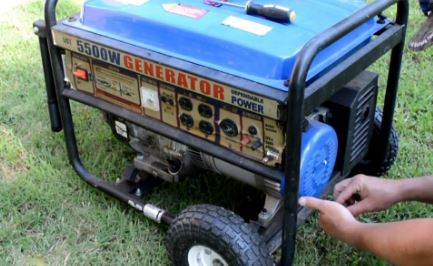A portable generator is a tool that many people rarely utilize. When you do need to use it, however, it’s critical that it works properly.
This is especially true in emergency scenarios such as power outages caused by severe weather.
In an emergency, what should you do if your portable generator won’t start? Continue reading to find out.
When your generator fails to start, there are a few things you can try. In the vast majority of cases, this troubleshooting procedure will resolve the issue, and your generator will begin to operate.
To determine the exact placement of the items in concern for several of these stages, you’ll probably need to consult the handbook for your specific generator type.
Examine the Fundamentals
Check for all of the essentials before moving on to the next step of troubleshooting.
- Is there enough gas and oil in the generator?
- Is your fuel valve turned on?
- Is the choke engaged?
It’s easy to overlook any of these fundamentals, so double-check them before moving on to the next step.
Is the Fuel Fresh?
The fact that the gas is old is one of the most typical reasons why a generator won’t start. Fuel degrades when it sits for an extended amount of time.
If your fuel appears murky or separated, this is the most likely cause of the generator not starting.
You’ll need to siphon the gas out and replace it with new gas.
You can avoid this problem in the future by running your generator dry after each use or adding fuel stabilizer on a regular basis.
When you possess a portable generator, you must have a decent fuel stabilizer on standby.
Examine the Spark Plug
Check the condition of the spark plug by pulling it out.
If it appears to be unclean, clean it using carb cleaner. Spray some carb cleaner directly into the cylinder while the plug is being withdrawn.
If your generator still won’t start after you’ve tried everything else, you might want to consider changing the spark plug.
Even if they appear to be in good condition, spark plugs can go bad and wear out.
Fortunately, they are often inexpensive. It’s a good idea to keep a spare spark plug on hand in case of an emergency.
Examine the Air Filter
A generator requires airflow to operate, which a blocked air filter can preclude.
Pull the air filter out and inspect it for clogging.
If it doesn’t appear to be too terrible, you can just clean it. To shake off the dust, give it a light smack on the floor or a counter-top.
If it’s severely clogged or appears to be worn, it’s time to replace it.
Because air filters are quite inexpensive, it’s a good idea to keep a spare on hand.
Fuel Line and Fuel Filter Inspection
If your generator still won’t start, inspect your fuel line for any pinches, blockages, cracks, or leaks.
You may be able to fix the damage in some circumstances, but in most cases, you’ll need to replace the line.
Not all portable generators have fuel filters, but those that do should be checked.
This is yet another area that can become clogged.
Remove the gasoline line from the carburetor’s connection.
Check to see whether fuel gets through the filter. If no gas comes out of the filter, it’s probably clogged and needs to be replaced.
Because this is a less common problem, having a spare gasoline line on hand isn’t necessary, but it never hurts to be prepared.
Carburetor Cleaning
In the carburetor, old, deteriorated gas might cause complications.
You might be able to clean it without removing it entirely by simply spraying carb cleaner into the orifices and jets.
You’ll have to remove it in other circumstances. It’s critical to remember that carburetors are extremely sensitive.
It’s critical not to scratch it while taking it out and cleaning it.
Keep track of all the screws with care. There are a lot of small pieces, and you don’t want to lose any of them.
Electric Starts: Special Considerations
Make sure the battery on a generator with an electric starting system isn’t dead.
A multimeter can be used to verify this. Replace the battery if it is dead.
If the battery is in good condition, check for blown fuses and replace them as needed.
Finally, examine sure the battery terminals are free of corrosion and that the connections are secure.
Even if everything appears to be in order, you should clean the battery connections with a wire brush before reattaching them.
Regular Maintenance Is Important For Prevention
Finally, frequent preventative maintenance is the most effective way to ensure that your generator starts when you need it.
Stick to the maintenance schedule outlined in the owner’s manual.
It is critical to change the oil after a certain number of uses and to inspect the air filter and spark plugs as needed.
These routine maintenance actions will keep the unit in top functioning order for when it matters most.
If you only use your generator in an emergency, it’s likely that it’s been sitting idle for a long time. It’s preferable to run it dry in this situation. If you don’t want to do this, a gasoline stabilizer is definitely necessary.
It’s also a good idea to periodically check on the generator and operate it to ensure it’s still operational.
When you’re dealing with an emergency, the last thing you need to be worrying about is why your generator won’t start.
Allowing your portable generator to collect dust is a bad idea.
Take care of it and check on it on a regular basis to ensure that it will serve you well when the time comes.

